A Comprehensive Analysis of Cyber Warfare's Impact on the US
VerifiedAdded on 2019/09/22
|6
|1415
|478
Report
AI Summary
This report delves into the multifaceted impact of cyber warfare on the United States. It defines cyber warfare as internet-based conflict involving politically motivated attacks on information systems, including actions by nation-states and non-state actors. The report explores cyber-attacks and cyber-espionage, providing examples such as attacks on Serbia and Estonia, and the 'Ghost Net' incident in China. It emphasizes the US's vulnerability due to its dependence on the internet and its advanced technological capabilities. The report discusses military strategies, including the five pillars of cyber warfare: recognizing cyber-space as a new domain, proactive defense, protection of critical infrastructure, early detection, and technological advancements. It also highlights the role of fear, vulnerability, and spectacular factors in cyber-attacks, along with syntactic and semantic attack types, and intrusion kill chains. The report references several sources, including works by Andress et al., Johansson et al., Shakarian et al., Nicholson et al., and Colarik et al., to support its analysis.
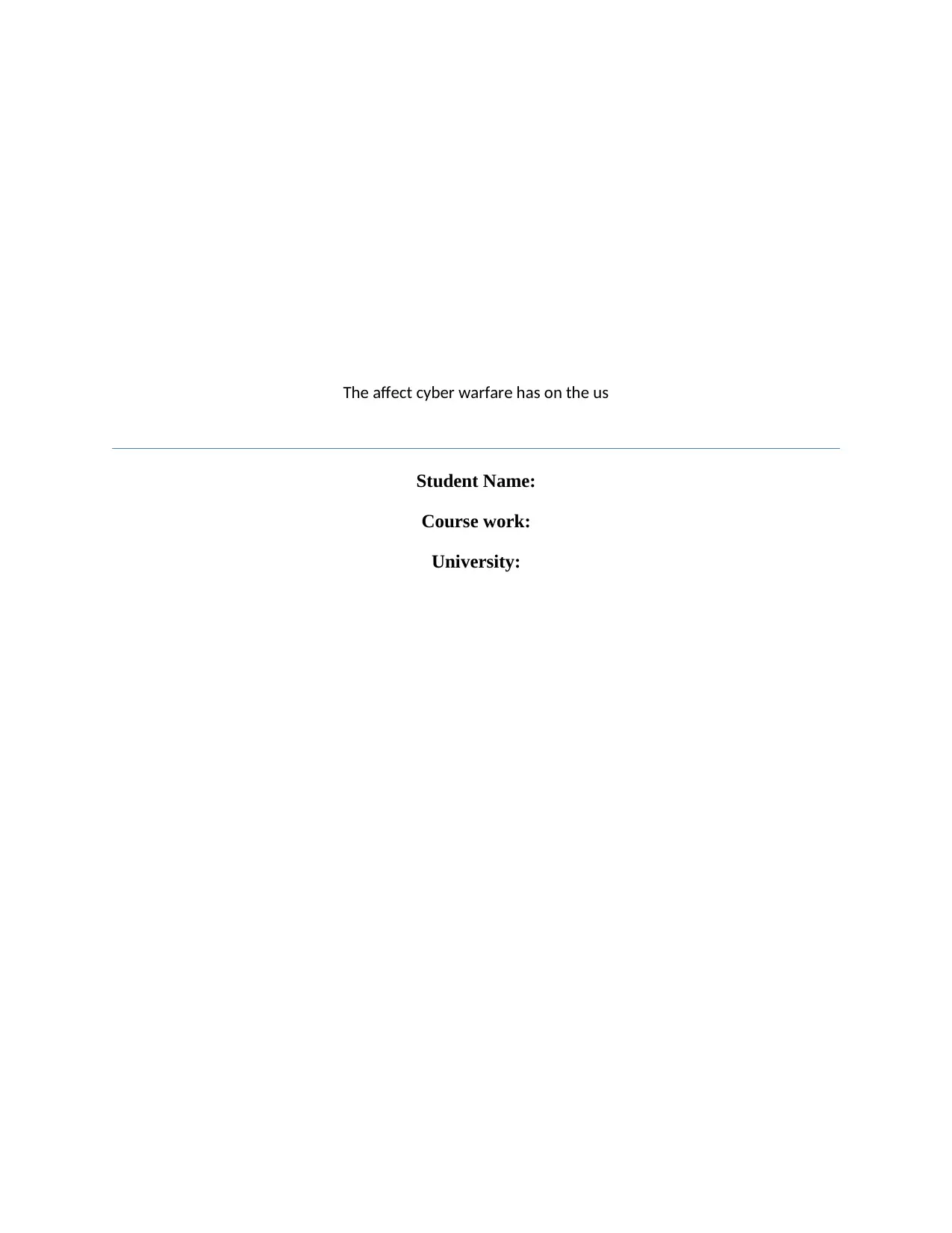
The affect cyber warfare has on the us
Student Name:
Course work:
University:
Student Name:
Course work:
University:
Paraphrase This Document
Need a fresh take? Get an instant paraphrase of this document with our AI Paraphraser
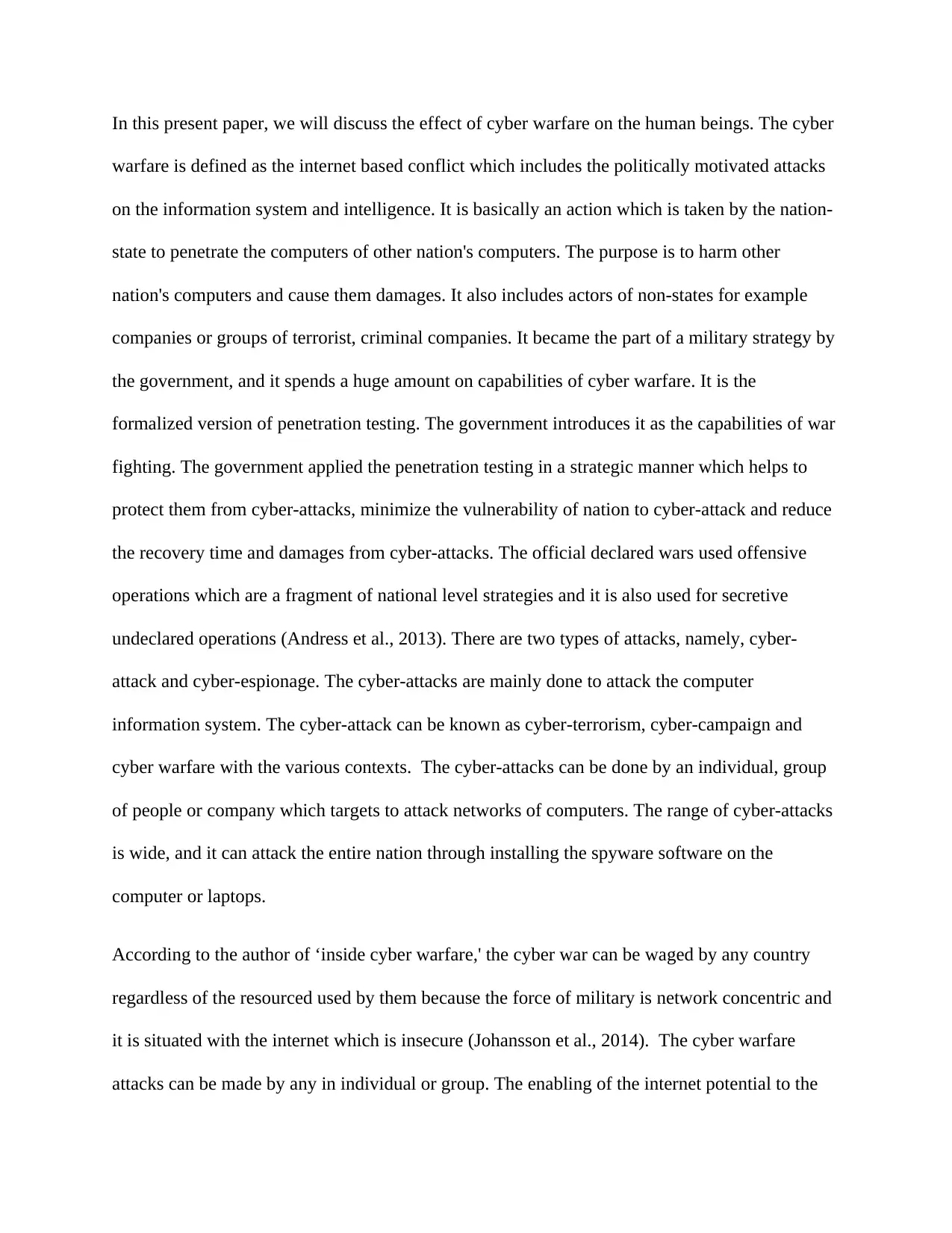
In this present paper, we will discuss the effect of cyber warfare on the human beings. The cyber
warfare is defined as the internet based conflict which includes the politically motivated attacks
on the information system and intelligence. It is basically an action which is taken by the nation-
state to penetrate the computers of other nation's computers. The purpose is to harm other
nation's computers and cause them damages. It also includes actors of non-states for example
companies or groups of terrorist, criminal companies. It became the part of a military strategy by
the government, and it spends a huge amount on capabilities of cyber warfare. It is the
formalized version of penetration testing. The government introduces it as the capabilities of war
fighting. The government applied the penetration testing in a strategic manner which helps to
protect them from cyber-attacks, minimize the vulnerability of nation to cyber-attack and reduce
the recovery time and damages from cyber-attacks. The official declared wars used offensive
operations which are a fragment of national level strategies and it is also used for secretive
undeclared operations (Andress et al., 2013). There are two types of attacks, namely, cyber-
attack and cyber-espionage. The cyber-attacks are mainly done to attack the computer
information system. The cyber-attack can be known as cyber-terrorism, cyber-campaign and
cyber warfare with the various contexts. The cyber-attacks can be done by an individual, group
of people or company which targets to attack networks of computers. The range of cyber-attacks
is wide, and it can attack the entire nation through installing the spyware software on the
computer or laptops.
According to the author of ‘inside cyber warfare,' the cyber war can be waged by any country
regardless of the resourced used by them because the force of military is network concentric and
it is situated with the internet which is insecure (Johansson et al., 2014). The cyber warfare
attacks can be made by any in individual or group. The enabling of the internet potential to the
warfare is defined as the internet based conflict which includes the politically motivated attacks
on the information system and intelligence. It is basically an action which is taken by the nation-
state to penetrate the computers of other nation's computers. The purpose is to harm other
nation's computers and cause them damages. It also includes actors of non-states for example
companies or groups of terrorist, criminal companies. It became the part of a military strategy by
the government, and it spends a huge amount on capabilities of cyber warfare. It is the
formalized version of penetration testing. The government introduces it as the capabilities of war
fighting. The government applied the penetration testing in a strategic manner which helps to
protect them from cyber-attacks, minimize the vulnerability of nation to cyber-attack and reduce
the recovery time and damages from cyber-attacks. The official declared wars used offensive
operations which are a fragment of national level strategies and it is also used for secretive
undeclared operations (Andress et al., 2013). There are two types of attacks, namely, cyber-
attack and cyber-espionage. The cyber-attacks are mainly done to attack the computer
information system. The cyber-attack can be known as cyber-terrorism, cyber-campaign and
cyber warfare with the various contexts. The cyber-attacks can be done by an individual, group
of people or company which targets to attack networks of computers. The range of cyber-attacks
is wide, and it can attack the entire nation through installing the spyware software on the
computer or laptops.
According to the author of ‘inside cyber warfare,' the cyber war can be waged by any country
regardless of the resourced used by them because the force of military is network concentric and
it is situated with the internet which is insecure (Johansson et al., 2014). The cyber warfare
attacks can be made by any in individual or group. The enabling of the internet potential to the
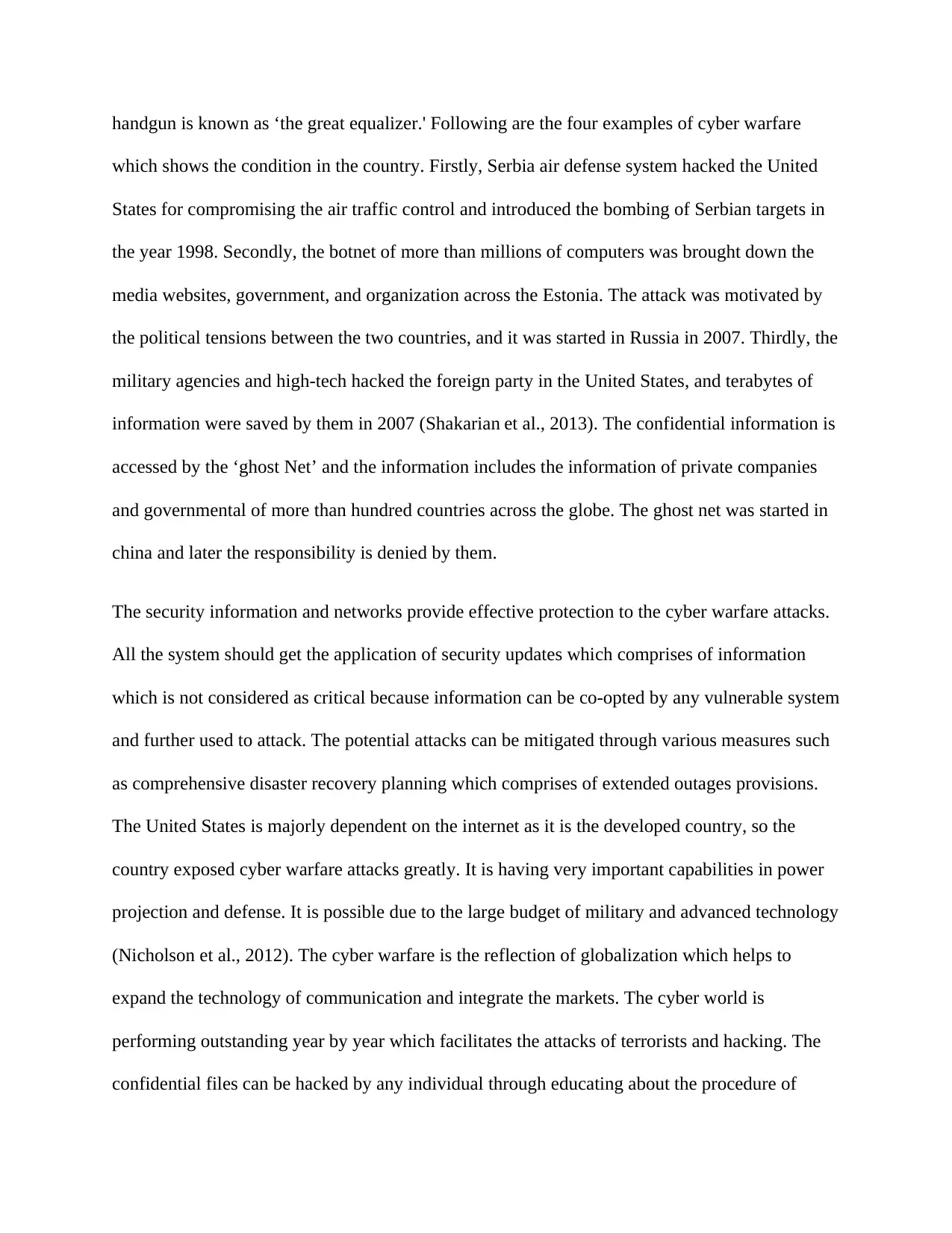
handgun is known as ‘the great equalizer.' Following are the four examples of cyber warfare
which shows the condition in the country. Firstly, Serbia air defense system hacked the United
States for compromising the air traffic control and introduced the bombing of Serbian targets in
the year 1998. Secondly, the botnet of more than millions of computers was brought down the
media websites, government, and organization across the Estonia. The attack was motivated by
the political tensions between the two countries, and it was started in Russia in 2007. Thirdly, the
military agencies and high-tech hacked the foreign party in the United States, and terabytes of
information were saved by them in 2007 (Shakarian et al., 2013). The confidential information is
accessed by the ‘ghost Net’ and the information includes the information of private companies
and governmental of more than hundred countries across the globe. The ghost net was started in
china and later the responsibility is denied by them.
The security information and networks provide effective protection to the cyber warfare attacks.
All the system should get the application of security updates which comprises of information
which is not considered as critical because information can be co-opted by any vulnerable system
and further used to attack. The potential attacks can be mitigated through various measures such
as comprehensive disaster recovery planning which comprises of extended outages provisions.
The United States is majorly dependent on the internet as it is the developed country, so the
country exposed cyber warfare attacks greatly. It is having very important capabilities in power
projection and defense. It is possible due to the large budget of military and advanced technology
(Nicholson et al., 2012). The cyber warfare is the reflection of globalization which helps to
expand the technology of communication and integrate the markets. The cyber world is
performing outstanding year by year which facilitates the attacks of terrorists and hacking. The
confidential files can be hacked by any individual through educating about the procedure of
which shows the condition in the country. Firstly, Serbia air defense system hacked the United
States for compromising the air traffic control and introduced the bombing of Serbian targets in
the year 1998. Secondly, the botnet of more than millions of computers was brought down the
media websites, government, and organization across the Estonia. The attack was motivated by
the political tensions between the two countries, and it was started in Russia in 2007. Thirdly, the
military agencies and high-tech hacked the foreign party in the United States, and terabytes of
information were saved by them in 2007 (Shakarian et al., 2013). The confidential information is
accessed by the ‘ghost Net’ and the information includes the information of private companies
and governmental of more than hundred countries across the globe. The ghost net was started in
china and later the responsibility is denied by them.
The security information and networks provide effective protection to the cyber warfare attacks.
All the system should get the application of security updates which comprises of information
which is not considered as critical because information can be co-opted by any vulnerable system
and further used to attack. The potential attacks can be mitigated through various measures such
as comprehensive disaster recovery planning which comprises of extended outages provisions.
The United States is majorly dependent on the internet as it is the developed country, so the
country exposed cyber warfare attacks greatly. It is having very important capabilities in power
projection and defense. It is possible due to the large budget of military and advanced technology
(Nicholson et al., 2012). The cyber warfare is the reflection of globalization which helps to
expand the technology of communication and integrate the markets. The cyber world is
performing outstanding year by year which facilitates the attacks of terrorists and hacking. The
confidential files can be hacked by any individual through educating about the procedure of
⊘ This is a preview!⊘
Do you want full access?
Subscribe today to unlock all pages.

Trusted by 1+ million students worldwide
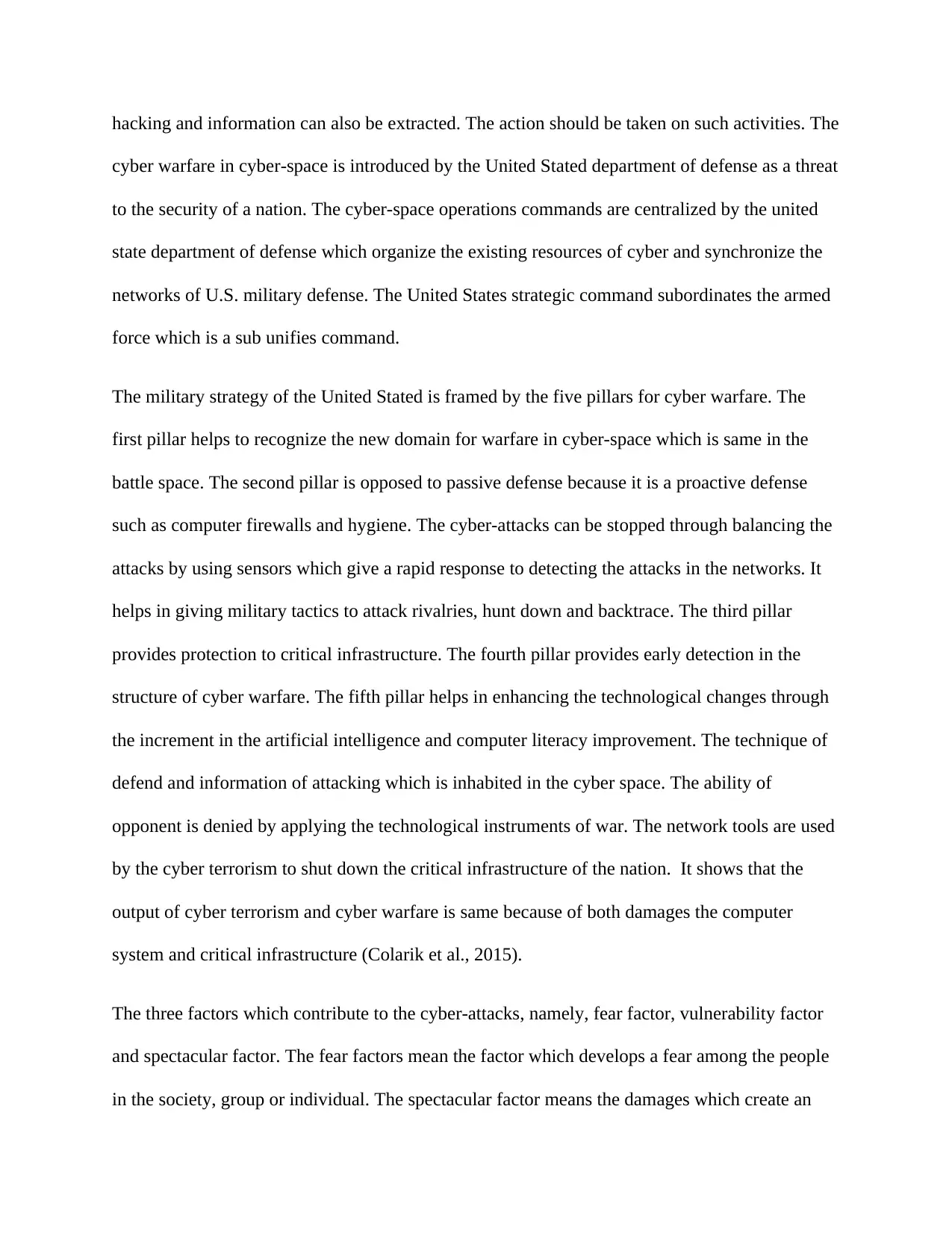
hacking and information can also be extracted. The action should be taken on such activities. The
cyber warfare in cyber-space is introduced by the United Stated department of defense as a threat
to the security of a nation. The cyber-space operations commands are centralized by the united
state department of defense which organize the existing resources of cyber and synchronize the
networks of U.S. military defense. The United States strategic command subordinates the armed
force which is a sub unifies command.
The military strategy of the United Stated is framed by the five pillars for cyber warfare. The
first pillar helps to recognize the new domain for warfare in cyber-space which is same in the
battle space. The second pillar is opposed to passive defense because it is a proactive defense
such as computer firewalls and hygiene. The cyber-attacks can be stopped through balancing the
attacks by using sensors which give a rapid response to detecting the attacks in the networks. It
helps in giving military tactics to attack rivalries, hunt down and backtrace. The third pillar
provides protection to critical infrastructure. The fourth pillar provides early detection in the
structure of cyber warfare. The fifth pillar helps in enhancing the technological changes through
the increment in the artificial intelligence and computer literacy improvement. The technique of
defend and information of attacking which is inhabited in the cyber space. The ability of
opponent is denied by applying the technological instruments of war. The network tools are used
by the cyber terrorism to shut down the critical infrastructure of the nation. It shows that the
output of cyber terrorism and cyber warfare is same because of both damages the computer
system and critical infrastructure (Colarik et al., 2015).
The three factors which contribute to the cyber-attacks, namely, fear factor, vulnerability factor
and spectacular factor. The fear factors mean the factor which develops a fear among the people
in the society, group or individual. The spectacular factor means the damages which create an
cyber warfare in cyber-space is introduced by the United Stated department of defense as a threat
to the security of a nation. The cyber-space operations commands are centralized by the united
state department of defense which organize the existing resources of cyber and synchronize the
networks of U.S. military defense. The United States strategic command subordinates the armed
force which is a sub unifies command.
The military strategy of the United Stated is framed by the five pillars for cyber warfare. The
first pillar helps to recognize the new domain for warfare in cyber-space which is same in the
battle space. The second pillar is opposed to passive defense because it is a proactive defense
such as computer firewalls and hygiene. The cyber-attacks can be stopped through balancing the
attacks by using sensors which give a rapid response to detecting the attacks in the networks. It
helps in giving military tactics to attack rivalries, hunt down and backtrace. The third pillar
provides protection to critical infrastructure. The fourth pillar provides early detection in the
structure of cyber warfare. The fifth pillar helps in enhancing the technological changes through
the increment in the artificial intelligence and computer literacy improvement. The technique of
defend and information of attacking which is inhabited in the cyber space. The ability of
opponent is denied by applying the technological instruments of war. The network tools are used
by the cyber terrorism to shut down the critical infrastructure of the nation. It shows that the
output of cyber terrorism and cyber warfare is same because of both damages the computer
system and critical infrastructure (Colarik et al., 2015).
The three factors which contribute to the cyber-attacks, namely, fear factor, vulnerability factor
and spectacular factor. The fear factors mean the factor which develops a fear among the people
in the society, group or individual. The spectacular factor means the damages which create an
Paraphrase This Document
Need a fresh take? Get an instant paraphrase of this document with our AI Paraphraser
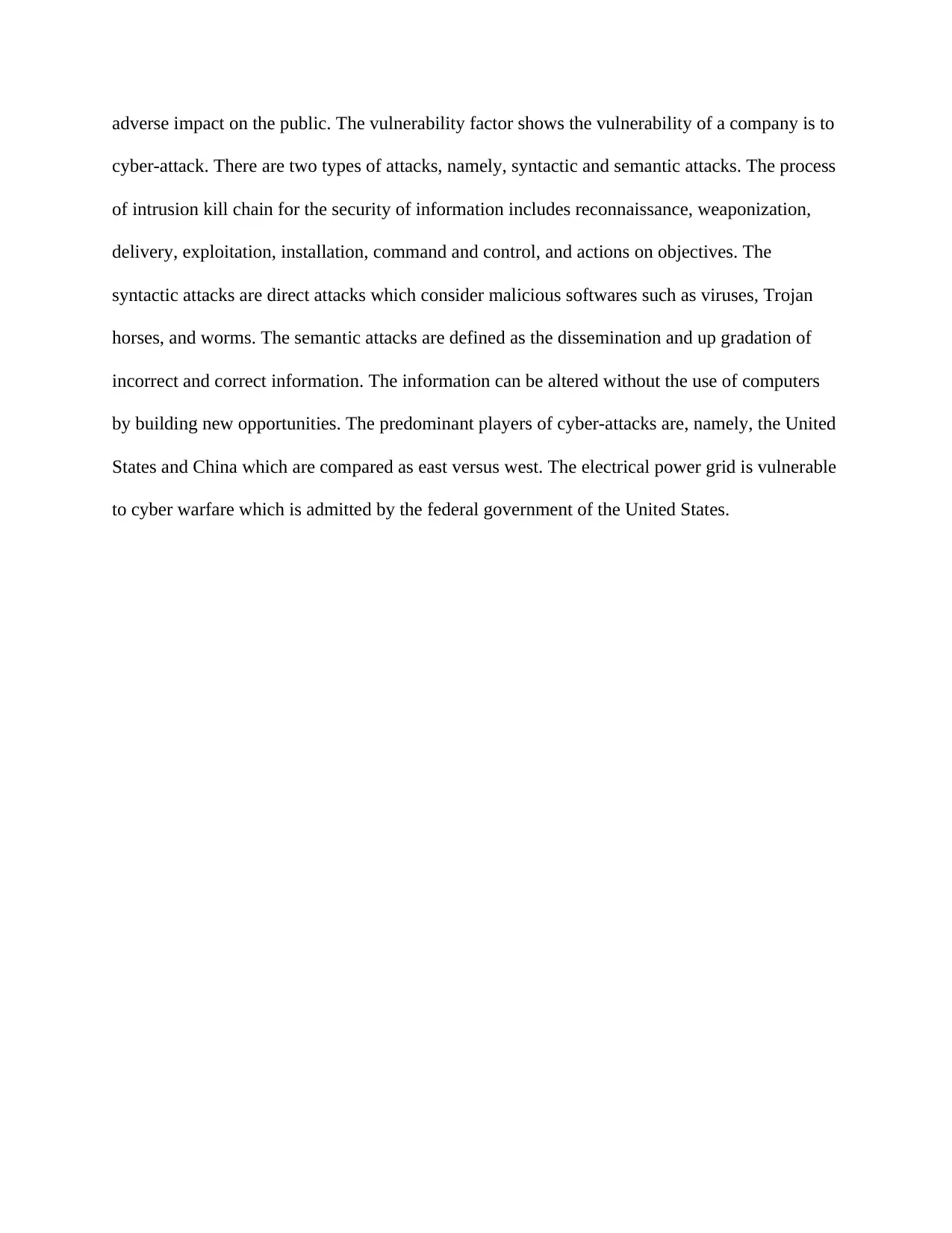
adverse impact on the public. The vulnerability factor shows the vulnerability of a company is to
cyber-attack. There are two types of attacks, namely, syntactic and semantic attacks. The process
of intrusion kill chain for the security of information includes reconnaissance, weaponization,
delivery, exploitation, installation, command and control, and actions on objectives. The
syntactic attacks are direct attacks which consider malicious softwares such as viruses, Trojan
horses, and worms. The semantic attacks are defined as the dissemination and up gradation of
incorrect and correct information. The information can be altered without the use of computers
by building new opportunities. The predominant players of cyber-attacks are, namely, the United
States and China which are compared as east versus west. The electrical power grid is vulnerable
to cyber warfare which is admitted by the federal government of the United States.
cyber-attack. There are two types of attacks, namely, syntactic and semantic attacks. The process
of intrusion kill chain for the security of information includes reconnaissance, weaponization,
delivery, exploitation, installation, command and control, and actions on objectives. The
syntactic attacks are direct attacks which consider malicious softwares such as viruses, Trojan
horses, and worms. The semantic attacks are defined as the dissemination and up gradation of
incorrect and correct information. The information can be altered without the use of computers
by building new opportunities. The predominant players of cyber-attacks are, namely, the United
States and China which are compared as east versus west. The electrical power grid is vulnerable
to cyber warfare which is admitted by the federal government of the United States.
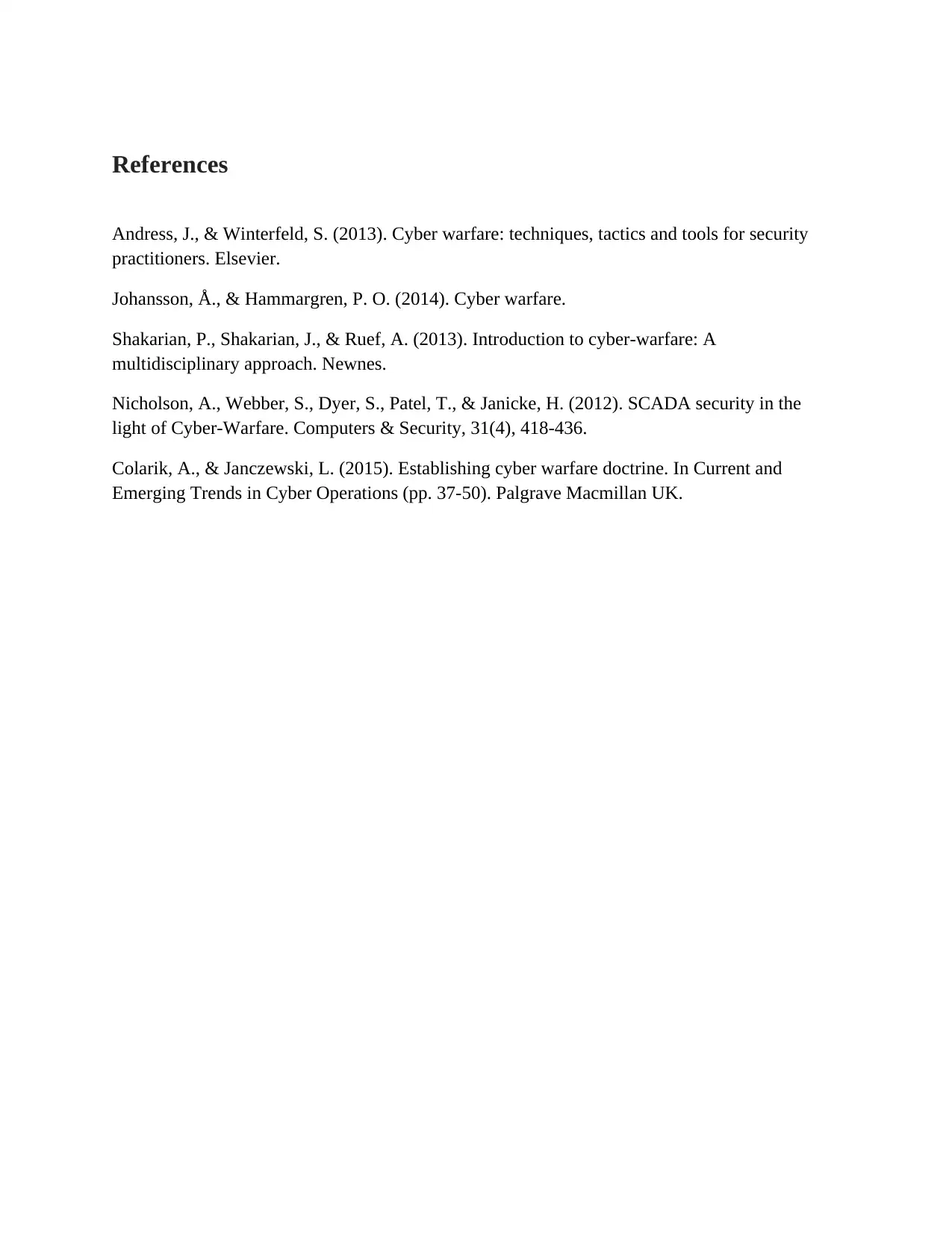
References
Andress, J., & Winterfeld, S. (2013). Cyber warfare: techniques, tactics and tools for security
practitioners. Elsevier.
Johansson, Å., & Hammargren, P. O. (2014). Cyber warfare.
Shakarian, P., Shakarian, J., & Ruef, A. (2013). Introduction to cyber-warfare: A
multidisciplinary approach. Newnes.
Nicholson, A., Webber, S., Dyer, S., Patel, T., & Janicke, H. (2012). SCADA security in the
light of Cyber-Warfare. Computers & Security, 31(4), 418-436.
Colarik, A., & Janczewski, L. (2015). Establishing cyber warfare doctrine. In Current and
Emerging Trends in Cyber Operations (pp. 37-50). Palgrave Macmillan UK.
Andress, J., & Winterfeld, S. (2013). Cyber warfare: techniques, tactics and tools for security
practitioners. Elsevier.
Johansson, Å., & Hammargren, P. O. (2014). Cyber warfare.
Shakarian, P., Shakarian, J., & Ruef, A. (2013). Introduction to cyber-warfare: A
multidisciplinary approach. Newnes.
Nicholson, A., Webber, S., Dyer, S., Patel, T., & Janicke, H. (2012). SCADA security in the
light of Cyber-Warfare. Computers & Security, 31(4), 418-436.
Colarik, A., & Janczewski, L. (2015). Establishing cyber warfare doctrine. In Current and
Emerging Trends in Cyber Operations (pp. 37-50). Palgrave Macmillan UK.
⊘ This is a preview!⊘
Do you want full access?
Subscribe today to unlock all pages.

Trusted by 1+ million students worldwide
1 out of 6
Related Documents
Your All-in-One AI-Powered Toolkit for Academic Success.
+13062052269
info@desklib.com
Available 24*7 on WhatsApp / Email
![[object Object]](/_next/static/media/star-bottom.7253800d.svg)
Unlock your academic potential
Copyright © 2020–2025 A2Z Services. All Rights Reserved. Developed and managed by ZUCOL.





